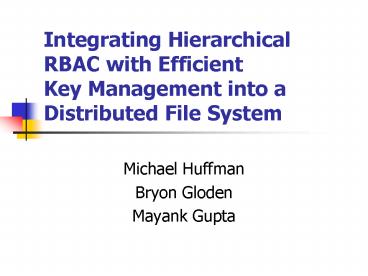Integrating Hierarchical RBAC with Efficient Key Management into a Distributed File System - PowerPoint PPT Presentation
1 / 10
Title:
Integrating Hierarchical RBAC with Efficient Key Management into a Distributed File System
Description:
Bryon Gloden. Mayank Gupta. Motivation. A working model where multiple users can access ... A real-world example is where companies must protect their ... – PowerPoint PPT presentation
Number of Views:26
Avg rating:3.0/5.0
Title: Integrating Hierarchical RBAC with Efficient Key Management into a Distributed File System
1
Integrating Hierarchical RBAC with EfficientKey
Management into a Distributed File System
- Michael Huffman
- Bryon Gloden
- Mayank Gupta
2
Motivation
- A working model where multiple users can access
company data based on their current role within
the company and where communication is done
securely. - A real-world example is where companies must
protect their information from unauthorized
access.
3
Related Work
- Brewer F. Mash M. (1989). The Chinese Wall
Security Policy. IEEE Security and Privacy. - Frikken k., Atallah M., Bykova M. (2004).
Hash-Based Access Control in an arbitrary
hierarchy. CERIAS Tech Report 2004-49. - Gloden B. Huffman M. (2005). Secure Group
Communication. CS 555 project. - Sandhu R., Coyne E., Fienstein H., Youman C.
(1996). Role-based Access Control models. IEEE
computer.
4
Overview of Our Approach
- We have integrated a client-server application
with a hierarchical role-based access control
system. - The clients use a client application to
authenticate and interact with a remote server or
file system. Depending on the users role, they
are allowed execute primitive remote procedures. - All of the communication between the server and
the client systems is encrypted using AES with a
random 128-bit individual session key (ISK).
5
Secure Group Communication
- Each time a client connects to the server, the
client will need to encrypt a data packet asking
to join the system using a symmetric encryption
authentication key (AK). - Once the client has been successfully
authenticated to the server, the server will send
back an individual session key (ISK) that will be
only shared between this client and the server.
All communication done between this client and
the server will utilize this key. - These ISKs are generated on a per-user,
per-session basis.
6
Hierarchical RBAC
- Our implementation only supports three roles (VP,
Manager and Engineer) but other roles can be
added to the system. - The role VP has the maximum number of privileges
and the role Engineer has the minimum number of
privileges. - The following functions are implemented create
a file, create a directory, copy a file, delete a
file, delete a directory
7
Efficient Key Management for Hierarchical RBAC
Where i is the dominate role, j is the
subordinate role, Hash is the same MD5 hash
function used to generate L and K, and p is the
size of the key (128 bits in our case).
8
Implementation - Client
9
Implementation - Server
10
Conclusion and Future Work
- We have successfully shown by our experiments
that efficient key management can be implemented
in a hierarchical RBAC system. - We have also successfully integrated RBAC with
the secure group communication. - History-based access control

